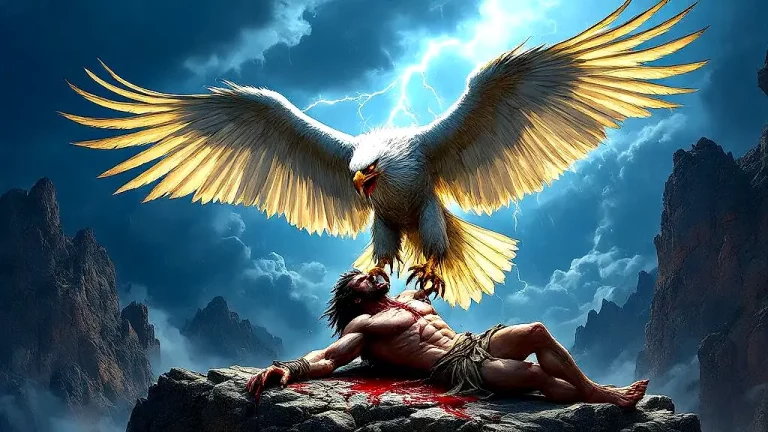Zephyros: Greek God Of The West Wind, Spring, And Fertility
Welcome to our look into Zephyros, the Greek god of the west wind, spring, and fertility. Think about the breeze that marks the end of cold months and the start of a season with blooming flowers and new life – that’s Zephyros working. In Greek myths, Zephyros is a big figure who stands for the fresh and life-bringing parts of nature.
Key Points:
- Zephyros, also called Zephyrus, is a Greek god who represents the west wind, spring and fertility, born from Astraeus and Eos.
- Zephyros is part of the Anemoi, the wind gods, along with Boreas, Notus, and Eurus, each of them ruling a cardinal direction.
- His actions are seen in the arrival of the warm, gentle breezes that mark the beginning of spring and the blooming of nature.
- In Greek myths, Zephyros is known for transforming the nymph Chloris into Flora, the goddess of flowers, signifying the arrival of spring, and for his rivalry with Boreas over the love of Podarge.
- Zephyros is symbolized by the west wind, flowers, and gentle breezes, all representing life, renewal, and growth.
- His influence in ancient Greece can be seen in farming, celebrations, and daily life, with his arrival marking the start of planting season and festivities honoring new life.
- The legacy of Zephyros is still present in modern culture through references in books, art, and popular media, where he symbolizes gentle change and the renewal of life.
As we go through this blog post, you will find out about his beginnings, his part in various myths, and his ties with other gods and humans. We’ll also look at the symbols linked with Zephyros, his effect on the changing seasons, and how he has been represented in old art.
By the time you finish this trip, you’ll have a complete picture of Zephyros and his lasting mark in both old and current culture.
Zephyros: Overview and Key Facts
| Aspect | Details |
|---|---|
| Name | Zephyros (also spelled Zephyrus) |
| Role | God of the west wind, spring, and fertility |
| Parentage | From Astraeus (Titan of the dusk) and Eos (Goddess of the dawn) |
| Siblings | Boreas (north wind), Notus (south wind), Eurus (east wind) |
| Consort | Chloris (flower nymph, later known as Flora, goddess of flowers) |
| Symbols | West wind, flowers, gentle breezes |
| Attributes | Gentle nature, brings spring, linked to growth and fertility |
| Significant Myths | Tie with Chloris, part in many myth stories |
| Cultural Impact | Affects farming, parties, daily life in early Greece |
| Depictions in Art | Often seen as a young one with wings, holding flowers |
| Legacy | Still mentioned in books, art, and pop culture |
Getting to Know Zephyros
To truly understand Zephyros’ role in Greek mythology, it’s important. We need to look closer at where he came from. Moreover, we should think about what he means, and the stories that talk about him.
Who is Zephyros?
Zephyros, also called Zephyrus, is an essential figure in Greek mythology. He is known as the god of the west wind, spring, and fertility. He comes from Astraeus, the Titan of dusk, and Eos, the goddess of dawn. Zephyros is one of the AnemOI, the wind gods who each rule over a cardinal direction.
Think of the gentle breeze that brings warmth and the start of spring – that is Zephyros working. His role in nature is important because he brings the mild and helpful west wind which supports growth and fertility. This makes him a symbol of life and renewal.
Zephyros is a vital figure in Greek mythology as the god of the west wind, spring, and fertility, symbolizing life and renewal by bringing warmth and supporting growth with his gentle breeze.
Zephyros in Stories
To really get what Zephyros means, we need to look into the myths and stories about him. They make clear his connections and what they mean. His role and the tales told about him show his importance.
Myths Involving Zephyros
Zephyros is in a lot of Greek myths, often dealing with both gods and mortals. One big myth is about his connection with the nymph Chloris, who he changes into Flora, the goddess of flowers. This shows the coming of spring. Another story is his fight with Boreas, the god of the north wind, over the love of Podarge.
This shows how wind gods interact. Also, Zephyros helps Psyche in her quest to meet Eros again by softly carrying her to his palace, which means he is kind. These stories do two things. They show how Zephyros brings life and growth. And they make clear his interactions and connections with other gods in Greek mythology.
Zephyros and the Nymph Chloris
The story about Zephyros and Chloris means the start of spring and the growing of nature. Zephyros, charmed by how Chloris looked, chased her slowly and gently, like a spring wind. In time, he won her love, and by joining together, Chloris changed into Flora, the Roman goddess of flowers.
The change is like seeing a garden grow after a long winter, where the touch of Zephyros’ west wind means life and color come to the world. Their connection is a vivid sign of new life and fertility. Flora’s being there marks the growing of flowers and the new life of the earth, showing the true feeling of spring.
Symbols and Traits
To know more about Zephyros, we will look into the symbols and features that describe him and make clear his role in Greek mythology.
Symbols Linked to Zephyros
Several symbols are connected to Zephyros and describe his character and area. The main symbol is the west wind, which he personifies. Often, this wind is a gentle breeze. It is like the refreshing gusts you might feel on a nice spring day. This means renewal and growth. Flowers are another key symbol connected with Zephyros. They mean he is linked to spring and fertility.
Just as flowers grow when spring comes, Zephyros’ presence marks new life. Gentle breezes also make clear the character of Zephyros. They show his mild and nurturing nature. Together, these symbols highlight his role in making nature new and helping life grow.

- West Wind: Means renewal and growth, shown by Zephyros.
- Flowers: Stand for spring and fertility, growing with Zephyros’ coming.
- Gentle Breezes: Mean Zephyros’ mild and nurturing character.
Qualities of Zephyros
Zephyros is known for being gentle and caring, like soft winds that mean winter is ending and spring is starting. It is clear that he makes life return because he is connected to fertility; like how a gardener takes care of plants, ensuring they grow and thrive. Because of this, Zephyros is a sign of spring and means new beginnings and growth.
His mild nature is different from the stronger winds of others, making him calm and bringing renewal. Together, these features mean he is important in Greek mythology as someone who brings life and is a mild force of nature.
Zephyros and the Seasons
Since we looked at the signs and features of Zephyros, we should see how he plays a big part in the seasons changing, especially his effect on the coming of spring.
Zephyros’ Role in Spring
Zephyros is closely tied to the coming of spring by being the form of the west wind, which marks the end of the cold months and the start of the warm season. When you feel the first bit of warm wind after a long, cold time; this is the core of Zephyros’ impact.
The west wind he stands for is soft yet refreshing, helping plants grow and flowers bloom, much like a gardener’s caring hands. This wind promises renewal and makes the earth wake from being asleep. In Greek stories, Zephyros means life gets ready to start again, making him a vital force in the repeating nature of the seasons.

Zephyros symbolizes the onset of spring as the gentle west wind that brings warmth after winter, nurturing growth in nature and signaling the rebirth of life in Greek mythology.
Seasonal Stories and Rituals
In old Greek stories, people remembered Zephyros with different myths and events that marked the change of seasons. There is an important story about Zephyros loving the nymph Chloris. She changes into Flora, the goddess of flowers, meaning the beginning of spring. This story was told during the change of seasons to explain how nature starts to bloom.
Ceremonies for Zephyros included giving gifts and prayers to make sure spring would be good, like how today we have spring festivals with flowers and dances. These old events were deeply tied to farming, because the west wind’s coming was crucial for plants to grow and for life to renew.
By honoring Zephyros, people asked for his gentle breezes to ensure a good season ahead.
Zephyros in Art and Stories
After we looked at the stories and events about Zephyros, let’s now look deeply into how he has been shown in old Greek art and writings. How he appears.
Pictures in Ancient Art
Zephyros was a common subject in old Greek art. You see him in different forms like sculptures, pottery, and frescoes. Often, these artworks show his link to the west wind and spring. On sculptures, Zephyros usually appears as a young, winged figure, which means the gentle and refreshing nature of the west wind.

On pottery, he is often seen with other seasonal gods, showing his role in the natural cycle. Frescoes, such as those found in Pompeii, show Zephyros in nature scenes with flowers and greenery, meaning spring. These pictures are not just art; they are also stories showing how important he was in Greek mythology.
- Sculptures: Winged youthful figure, meaning the west wind.
- Pottery: Often seen with other seasonal gods, showing his role in the natural cycle.
- Frescoes: Nature scenes with flowers and greenery, meaning spring.
Comparing with Other Wind Gods
After we looked at Zephyros in art, let’s look at how he is similar or different from other wind gods in Greek mythology and beyond.
Greek Wind Gods
In Greek stories, Zephyros is one of the four AnemOI, or wind gods. They each show a main direction and are connected with specific weather changes. Zephyros, the west wind, means gentle breezes and spring. But Boreas, the north wind, is seen as a strong and powerful force, which means winter’s cold and hard storms.

Notus, the south wind, means the hot, dry winds of late summer and early fall, while Eurus, the east wind, is less seen but is usually connected with random and stormy weather. Knowing these differences is like knowing different weather changes.
| Wind God | Direction | Attributes | Domain | Mythological Stories |
|---|---|---|---|---|
| Zephyros | West | Gentle, Fertile | Spring | Love for Chloris, bringing spring |
| Boreas | North | Fierce, Cold | Winter | Abduction of Oreithyia, harsh storms |
| Notus | South | Hot, Dry | Late Summer, Early Autumn | Drying crops, hot winds |
| Eurus | East | Unpredictable, Stormy | Variable | Less prominent, stormy weather |
Wind Gods in Other Cultures
When we look at Zephyros and other wind gods from different stories, we see interesting likeness and differences. For example, the Roman god Favonius is basically similar to Zephyros. Both mean the west wind and are connected with spring and fertility. Favonius, just like Zephyros, appears as a gentle and caring force, bringing life and growth.
However, while Zephyros is often shown in the context of Greek myths and natural cycles, Favonius is more part of Roman agricultural practices and festivals, like the Floralia, which means the blooming of flowers and the renewal of life. But Njord, the Norse god, is different from wind gods. Njord is known with the sea and sailing, controlling not just the winds, but also the wealth and good luck from the ocean.
Unlike Zephyros, who is only linked to the west wind and spring, Njord‘s domain is broader, including all sea activities and the bounty of the sea. This difference means how different cultures give different roles and importance to their wind gods, reflecting their own environmental and societal needs.

While Zephyros brings the gentle breezes of spring, Njord commands the powerful winds that guide ships and bring prosperity to seafaring groups.
Zephyros’ Influence on Culture
Since we’ve checked out Zephyros‘ part among the wind gods, now let’s look into his impact on ancient Greek culture and see his lasting effect.
Cultural Impact in Ancient Greece
Zephyros had a big effect on culture in ancient Greece, especially in the areas of farming, parties, and everyday life. Because he was the god of the west wind, Zephyros was believed to bring gentle breezes. This meant spring was coming, a crucial time for planting crops and making sure the harvest was good.
Farmers depended on Zephyros for good weather, just like how modern farmers rely on weather reports. Additionally, festivals like the Anthesteria, which honored the blooming of flowers and the renewal of life, were closely linked to Zephyros‘ influence. These celebrations not only honored the god but also marked important seasonal changes that were vital to the agricultural calendar.

In daily life, the gentle winds of Zephyros were seen as a welcome break from the harsher conditions brought by other wind gods, meaning a time of growth, fertility, and renewal.
Zephyros, the god of the west wind in ancient Greece, greatly impacted farming, parties, and daily life by bringing gentle breezes that signaled the arrival of spring, crucial for planting crops and securing good harvests, which farmers relied on like today’s weather forecasts, with festivals like the Anthesteria honoring seasonal changes tied to Zephyros’ influence, symbolizing growth and renewal in a time of fertility.
Legacy of Zephyros
Zephyros‘ story lasts in today’s culture through many mentions in books, art, and popular things. In books, Zephyros often shows up as a symbol of gentle change and new life, much like how spring is shown in stories. For example, in the works of Romantic poets, the west wind is frequently called upon to mean new beginnings and the refreshing of nature.
In art, Zephyros is shown in many ways, from classic paintings to modern illustrations, often appearing as a young figure blowing a soft breeze, meaning the arrival of spring. Popular culture also takes on Zephyros, with mentions in movies, TV shows, and even video games, where he is often understood as a kind force of nature.
These modern ways keep the myth of Zephyros alive so new generations can see and understand this old sign of growth and new life.
Pantheon of Greek Mythology Gods
The group of Greek gods is big and complex, with each god having their own special parts and stories. Zeus, who is the king of the gods, and Hestia, who takes care of the home, are just some examples. These gods and goddesses controlled every part of ancient Greek life and the natural world.
If you want to see a full list of all the Greek gods, you can find a complete list of all the Greek Gods here. This full pantheon shows the rich and different mythology that has interested people for a long time, which gives insights into what ancient Greek people believed and valued.
FAQs
1. Who were the parents of Zephyros?
The parents of Zephyros were Astraeus, the Titan god of dusk, and Eos, the goddess of the dawn.
2. What are the main myths involving Zephyros?
The main myths involving Zephyros include his romantic relationship with the nymph Chloris and his rivalry with Boreas over the love of Hyacinthus.
3. How is Zephyros depicted in ancient art?
Zephyros is depicted in ancient art as a youthful, winged god often shown blowing a gentle breeze or surrounded by flowers.
4. What is the significance of Zephyros in Greek mythology?
The significance of Zephyros in Greek mythology lies in his role as the god of the west wind, symbolizing the arrival of spring and promoting fertility and growth.







